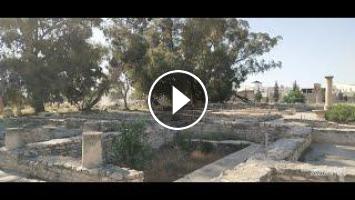20220514 Visiting Archaeological Museum of El Djem in Tunisia, History of Ancient Thysdrus part 6
Discover the History of Ancient Thysdrus
@archivistsinger41
Archaeological Museum
The Archaeological Museum in El Jem is a Tunisian museum located in El Jem, the old city of Thysdrus. The museum opened its doors on 26th October 1970 and was remodeled in 2002.
The museum is adjacent to many ancient Roman theaters - the latest being El Jem Theater, the largest and best preserved amphitheater, which has been included in the World Heritage List.
The museum was built on the ruins of a Roman house, restoring its spatial organization: a central courtyard surrounded by a roof-covered courtyard that opens to the rooms. There were exhibits - sculptures, mosaics, ceramics, etc. - from excavations carried out in Thysdrus and on the outskirts of the city
The Archaeological Gardens
This space has recently been enriched by a new wing that eloquently depicts the richness and diversity of industries in the Roman era.
The museum provides direct access to an "archaeological park" containing the ruins of a house called the House of the Peacock and Solertiana, a luxurious residence of the nobles in which a large number of its mosaics were preserved in their original location.
In the same space, 'Dar Afrika', the house Africa, was remodeled in its true size, a grand aristocratic residence, built around 170 and discovered by chance in the 1990s. It was named after two mosaics in their central medal; the first of the 'Princess Africa', and the second of the Province of Africa, the only known representation of the African continent
Discover the History of Ancient Thysdrus
@archivistsinger41
Archaeological Museum
The Archaeological Museum in El Jem is a Tunisian museum located in El Jem, the old city of Thysdrus. The museum opened its doors on 26th October 1970 and was remodeled in 2002.
The museum is adjacent to many ancient Roman theaters - the latest being El Jem Theater, the largest and best preserved amphitheater, which has been included in the World Heritage List.
The museum was built on the ruins of a Roman house, restoring its spatial organization: a central courtyard surrounded by a roof-covered courtyard that opens to the rooms. There were exhibits - sculptures, mosaics, ceramics, etc. - from excavations carried out in Thysdrus and on the outskirts of the city
The Archaeological Gardens
This space has recently been enriched by a new wing that eloquently depicts the richness and diversity of industries in the Roman era.
The museum provides direct access to an "archaeological park" containing the ruins of a house called the House of the Peacock and Solertiana, a luxurious residence of the nobles in which a large number of its mosaics were preserved in their original location.
In the same space, 'Dar Afrika', the house Africa, was remodeled in its true size, a grand aristocratic residence, built around 170 and discovered by chance in the 1990s. It was named after two mosaics in their central medal; the first of the 'Princess Africa', and the second of the Province of Africa, the only known representation of the African continent
- Catégories
- Location Maison à louer




















Commentaires